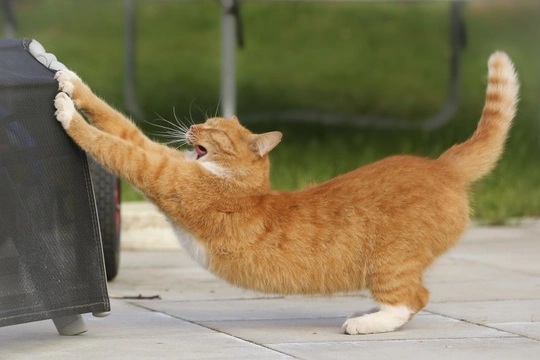
What makes cats so lithe and flexible?
Anyone who has ever owned a cat will have found themselves confounded at some stage by the strange shapes and positions that cats can contort themselves into, and some of the odd places and angles that they seem to find comfortable sleeping in! Cats are obviously very lithe and flexible animals that can and do get themselves into all sorts of weird places and positions, and they are also very supple and athletic, which gives them a distinct advantage as a small hunter.
A wide variety of factors that make up the cat’s conformation and skeletal structure combine to make them so flexible, sure-footed and athletic, and this encompasses a range of physical traits that are unmatched by any other mammal-not even dogs can come close!
If you have ever wondered how cats are able to bend, flex and move in the ways that they do-and how they can find such odd places and positions comfortable to sleep in-read on to learn the anatomy of what makes a cat a cat, and how this allows them to be so agile and flexible.
The cat’s spine
The construction of a cat’s spine accounts for a lot of their movement skills and ability to bend and flex, as well as enabling them to both stretch right out and curl up into a very small ball.
Humans have 33 vertebrae in their backs, dogs have 36 and cats have an impressive 53! For animals with tails (such as cats and dogs) the tail itself is part of the spine, and contains some of these vertebrae-with the exception of the Manx cat, a breed that has an absent or shorter than normal tail.
Additionally, the range of movement and rotation of the human spine is limited, making our backs relatively rigid and inflexible, due to the connective tissue between the vertebrae-but cats have more flexible connective tissue between each vertebra, giving them a larger degree of rotation and making cats able to fold their bodies into positions that even human contortionists could never hope to match! The connective tissue of the spine also acts as a cushioning shock absorber for the athletic cat, allowing them to twist and jump freely without jarring their backs or causing injuries.
This flexibility also contributes to the athleticism of cats, and their ability to fall on their feet-a process known as the cat self-righting mechanism. This mechanism is an instinctive movement that cats make whilst in mid-air, enabling them to correct the angle of their bodies whilst airborne so that they land on their feet.
Cats can also run at high speed and with a lot of power behind their movements, due to the extension and flexibility their spines are capable of. A cat running at full speed covers an area of ground around three times the length of their body with each stride, thanks to the length and flexibility of the spine and the power in their hind legs.
The tail
As mentioned, the cat’s tail is an extension of their spine, not simply an unrelated add-on, and cats have musculature in their tails that allows them to hold it erect, direct it, and use it to provide balance. Cats are very sure-footed as a result of the combination of their agility, gripping paws and claws and the added balance enabled by the position they hold their tails in.
The shoulders and clavicles
Cats can and do fit into some very narrow spaces, and when they stretch themselves out to full length, they can make themselves thin enough to get through spaces that might well seem impossible!
This is due to the construction of the cat’s shoulders and clavicles, which are again rather different to that of people.
The clavicles are the two long, horizontal bones that connect the shoulders and breastbone, which in humans, are connected firmly by joints with a limited range of movement. In cats, however, the clavicles are connected by strong muscle tissue and not by a ball and socket joint, again giving cats a superior range of movement in the shoulders, and masses of flexibility, and the ability to narrow the shoulders in order to fit through small spaces as the position of the clavicles is not fixed.
This also helps to contribute to the cat’s range of movement when walking and running too, and assists with their extension and running speed.
The legs and paws
Cats have a lot of strength and power in their limbs, particularly the hind limbs-so much so in fact that the average cat can leap up to nine times their own height from a sitting position, when we as humans are unlikely to reach our own heights from the same start!
Cats also have a high degree of rotation in their front limbs, using their hind limbs and hocks to power their movements and their front limbs for balance and to pivot. The strength of the hind limbs and their flexibility and suppleness enables cats to sit very still for long periods of time without stiffening up, allowing them to watch for prey and then spring into action immediately, jumping a long way with precision and stability to catch their prey.



